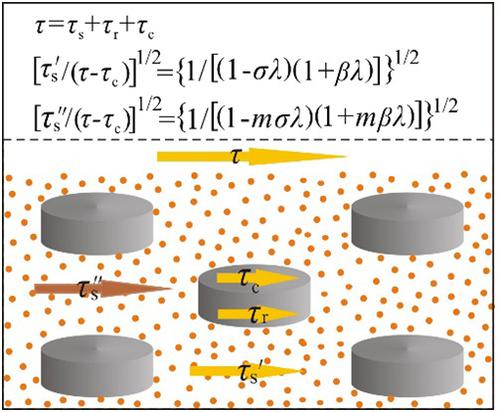当前位置:
X-MOL 学术
›
Earth Surf.Process. Land.
›
论文详情
Our official English website, www.x-mol.net, welcomes your
feedback! (Note: you will need to create a separate account there.)
A modified Raupach's model applicable for shear‐stress partitioning on surfaces covered with dense and flat‐shaped gravel roughness elements
Earth Surface Processes and Landforms ( IF 2.8 ) Pub Date : 2020-12-14 , DOI: 10.1002/esp.5052 Huiru Li 1 , Xueyong Zou 1 , Mengcui Zhang 1 , Liqiang Kang 1 , Chunlai Zhang 1 , Hong Cheng 1 , Xiaoxu Wu 2
Earth Surface Processes and Landforms ( IF 2.8 ) Pub Date : 2020-12-14 , DOI: 10.1002/esp.5052 Huiru Li 1 , Xueyong Zou 1 , Mengcui Zhang 1 , Liqiang Kang 1 , Chunlai Zhang 1 , Hong Cheng 1 , Xiaoxu Wu 2
Affiliation

|
A commonly used measure to prevent soil wind erosion is to cover the surface with gravel. Gravel can inhibit soil erosion by covering the surface directly, changing the airflow field near the surface and sharing the shear stress of wind. Similar to other roughness elements, the protective effect of gravel on soil is usually expressed in terms of the ratio of the shear stress on the exposed soil surface to the total shear stress on the rough surface due to wind, i.e. through a shear‐stress partitioning model. However, the existing shear‐stress partitioning models, represented by Raupach's model (RM93), are only applicable when the lateral coverage of the roughness elements, λ < 0.10, and the applicability of the models to flat‐shaped roughness elements is unclear. The purpose of this study is to verify the applicability of RM93 for dense and flat‐shaped gravel roughness elements by using shear‐stress data from wind‐tunnel measurements pertaining to roughness elements with different densities (0.013 ≤ λ ≤ 0.318) and flat shapes (height‐to‐width ratios in the range 0.20 ≤ H/W ≤ 0.63), and to modify RM93 to enhance its predictive ability. The results indicate that RM93 cannot accurately predict the shear‐stress partitioning for surfaces covered by densely distributed and flat‐shaped gravel roughness elements. This phenomenon occurs because, when roughness elements are distributed densely or are flat‐shaped, the proportion of the shear stress on the top surface of the roughness elements (τc) to the total shear stress (τ) is large; in this case, τc plays a dominant role and serves as an essential component in the shear‐stress partitioning model. Consequently, RM93 is modified by incorporating τc into the calculation of τ. Under conditions of λ < 0.32 and H/W > 0.2, the modified RM93 can yield satisfactory predictions regarding the shear‐stress partitioning.
中文翻译:

修改后的Raupach模型适用于在密实且扁平的砾石粗糙度元素覆盖的表面上进行剪应力分区
防止土壤风蚀的一种常用措施是用砾石覆盖表面。碎石可以通过直接覆盖地表,改变地表附近的气流场并分担风的切应力来抑制水土流失。与其他粗糙度元素类似,砾石对土壤的保护作用通常表示为裸露的土壤表面上的剪应力与风引起的粗糙表面上的总剪应力之比,即通过剪应力分区模型。但是,以Raupach模型(RM93)表示的现有剪应力分区模型仅适用于粗糙度元素的横向覆盖率λ <0.10,并且模型在平面形状的粗糙度元素上的适用性尚不清楚。本研究的目的是通过使用从风洞测量剪切应力有关的数据具有不同密度粗糙度元素(0.013≤验证RM93的适用性对致密且平坦形砾石粗糙度元件 λ ≤0.318)和扁平形状(高度与宽度的范围为0.20≤比率 ħ / w ^ ≤0.63),并修改RM93以增强其预测能力。结果表明,RM93不能准确预测由密集分布的扁平砾石粗糙度单元覆盖的表面的剪应力分区。发生这种现象是因为,当粗糙度元件密集分布或是扁平形的,剪切应力的粗糙度元素(的顶表面上的比例τ Ç)对总剪切应力(τ)大; 在这种情况下,τ Ç起主导作用,并且用作在剪切应力分区模型的必要成分。因此,RM93是通过将改性τ Ç到的计算τ。在以下条件下λ <0.32和H / W > 0.2,经过改进的RM93可以对剪切应力分配产生令人满意的预测。
更新日期:2020-12-14
中文翻译:

修改后的Raupach模型适用于在密实且扁平的砾石粗糙度元素覆盖的表面上进行剪应力分区
防止土壤风蚀的一种常用措施是用砾石覆盖表面。碎石可以通过直接覆盖地表,改变地表附近的气流场并分担风的切应力来抑制水土流失。与其他粗糙度元素类似,砾石对土壤的保护作用通常表示为裸露的土壤表面上的剪应力与风引起的粗糙表面上的总剪应力之比,即通过剪应力分区模型。但是,以Raupach模型(RM93)表示的现有剪应力分区模型仅适用于粗糙度元素的横向覆盖率λ <0.10,并且模型在平面形状的粗糙度元素上的适用性尚不清楚。本研究的目的是通过使用从风洞测量剪切应力有关的数据具有不同密度粗糙度元素(0.013≤验证RM93的适用性对致密且平坦形砾石粗糙度元件 λ ≤0.318)和扁平形状(高度与宽度的范围为0.20≤比率 ħ / w ^ ≤0.63),并修改RM93以增强其预测能力。结果表明,RM93不能准确预测由密集分布的扁平砾石粗糙度单元覆盖的表面的剪应力分区。发生这种现象是因为,当粗糙度元件密集分布或是扁平形的,剪切应力的粗糙度元素(的顶表面上的比例τ Ç)对总剪切应力(τ)大; 在这种情况下,τ Ç起主导作用,并且用作在剪切应力分区模型的必要成分。因此,RM93是通过将改性τ Ç到的计算τ。在以下条件下λ <0.32和H / W > 0.2,经过改进的RM93可以对剪切应力分配产生令人满意的预测。









































 京公网安备 11010802027423号
京公网安备 11010802027423号